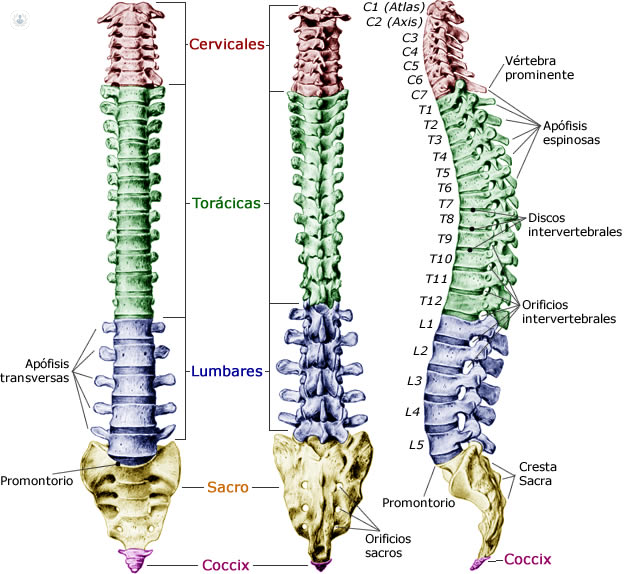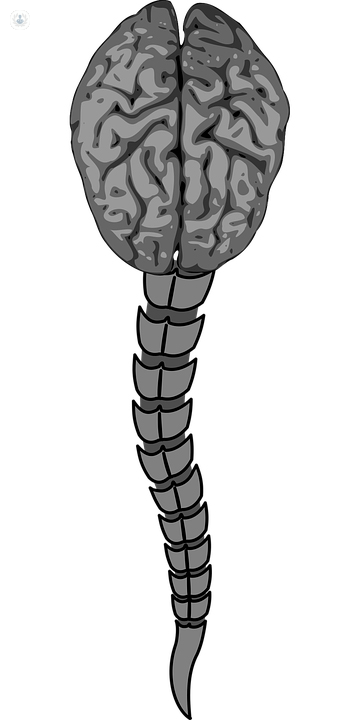Column fixation: which lesions are indicated and what is involved
Written by:The fixation of the lumbar spine allows restoring stability or correcting the alignment of the vertebrae in cases where there is an alteration, whether due to degenerative, post-surgical, congenital or traumatic processes.
In many cases, this fixation will be done by means of transpedicular screws , which are inserted in the vertebrae through the pedicle (portion that joins the anterior (body) and posterior (arch) vertebrae). This path allows a good anchorage point to be obtained in order to achieve the desired correction. In other cases intersomatic boxes , a kind of wedges that are placed between the vertebrae. These will allow to obtain another point of support, at the same time that it will give greater stability to the column. While these are the most frequent methods there are many others, such as interspinous devices, screws to lateral masses, screws laminares, among others.
Why the column fixation is performed
The specialist in Neurosurgery will indicate the fixation of a column in cases where the curvature of the spine needs to be corrected (balance), in cases where there is an instability of the spine (excessive displacement of one vertebra with respect to the other) or when We foresee an instability secondary to a surgical maneuver, such as surgery for canal stenosis.

Fixation will be the norm in disc herniation surgery in the cervical spine, since simple discectomy has been shown to lead to the appearance of cervical kyphosis (a change in the curvature of the spine) in 5-10 years, which is Associated with clinical deterioration.
Benefits of Spine Fixation for the Patient
The benefits come from the recovery of the stability of the column. Lumbar instability initially causes lumbar contractures, and difficulties may arise in ambulation, in the most severe cases, in which there may be a nerve entrapment secondary to this instability. Regarding the alteration of the balance the situation is similar; When the spine works in an unfavorable alignment it causes an early muscular fatigue that, equally, ends up causing contractures, fatigue and pain. In cases of advanced discopathy we will need intersomatic boxes to recover the height lost secondarily to the discopathy.
Potential risks of column fixation

The main risk of spinal fixation is associated with the neurological injury that can occur when inserting the arthrodesis material (fixation). That is why neurosurgeons use radiological methods to control the location of implanted material at any time, either by means of X-rays, intraoperative CT or neuron navigation systems. They also also have intraoperative monitoring systems to check the correct location of the system once implanted. For them a small current is applied to the fixation and, depending on the answer obtained, we will know the next one that is the system of artrodesis of the nerve roots. Other complications of any surgery, such as infection or bleeding, should be considered.. To avoid them, antibiotic prophylaxis is established before surgery and careful hemostasis is performed during surgery.
Indications to be followed by the patient undergoing spinal fixation
After surgery, whenever possible, early mobilization is established. This initial wandering should be prudent. The goal during the first month is not to recover muscle tone but to allow the muscles to heal and avoid complications in the arthrodesis system, which may appear when subjected to excessive tension when it is not yet integrated into the bone. Starting at 3-4 weeks mild rehabilitation treatment will begin, which will usually last for a month. During this time it is advised to avoid physical stresses, especially to load weights (> 3kg).
Once this period is over, it will be important to maintain a good muscle tone, so it is recommended to perform physical activities, avoiding the impact (running) and rotation (golf) and especially the combination of the same (squash). Toning the abdominal and lumbar musculature is of vital importance in patients with lumbar disease. The muscles are the wires that support the spine and, the better the tone of the spine, the lower the burden of joints, bones and ligaments.


